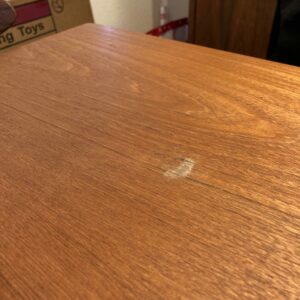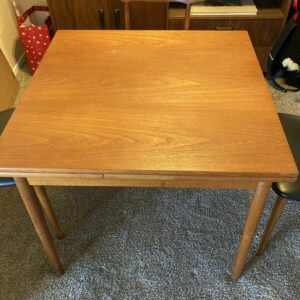My indoor teak table recently acquired some mold damage, and I am trying to find the best way to remove the mark.
While I would imagine that I could sand it out with some fine-grained sand-paper, I have never sanded a table or anything made of teak, so I don’t know if this will create a new area of discoloration compared to the rest of the top of the table.
It’s not a huge spot, so I might be able to live with it for a few years before doing a whole refinish to the table, but it would be nice if I could correct this small issue.
For some context: For the fall season I had kept a small gourd on the table as decoration. Little did I know it had started rotting on the bottom. Last time I decorated with live goards…

















Replies
I'll start with a disclaimer: this is what I would try if it were my table...
First test the finish in a blind spot. Start with some alcohol on a q-tip to see if anything comes off. If yes, you have shellac, if no try again with thinner or turps. If nothing comes off it is probably poly.
Put a bend in the spine of a single-edge razorblade (like from a box cutter) and use the convex edge as a scraper to clean up/out the damage...go easy on it and feather the edges of the damaged finish until you can barely feel it. Scrape another area away in your blind spot to simulate the damaged area to test finishes. (Do this first if you want to practice with the scraping) Don't be shy about tossing razors before they feel dull, they will scratch suddenly when they are.
First test for finish color is water. Wipe on just enough to see if it looks good or if the surrounding finish is more yellow... this tells you oil or water-based product. Test your best guess finish on the blind spot. Good luck!
Teak is very forgiving and the discoloration does not go deep in the wood. I would sand with 120/150 grit sandpaper using a backing block to avoid digging in until the gray disappears and apply some finish on the sanded area then sand a larger area with finer sandpaper area and add a coat or two blending in the area with the rest. You may want to add a final coat to the entire top to help in protecting the table in the future and blending in the repair.
I agree with all the advice above. I would guess that this is teak veneer. Some veneers are very thin and easy to sand/scrape through. I would use a light touch and stop just as soon as you have done enough.
I appreciate all of your thoughts! This is very helpful and within my abilities.